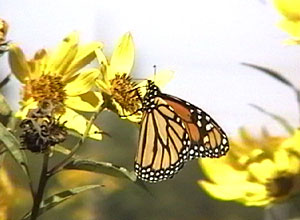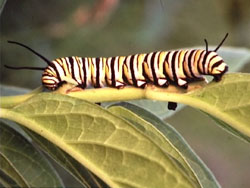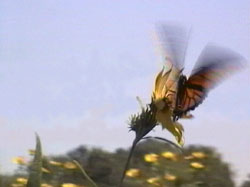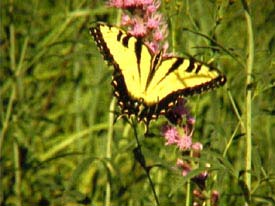Butterflies
Monarch
(Danaus plexippus)

The monarch is one of the best known butterflies and is noted for its migration
habits -- moving north to south. No single individual completes a round trip journey.
Flocks move to California and Mexico in fall, and resting migrants may cover entire trees.
In spring, they head northward as far as Canada producing 3 or 4 broods in one year.
video photo by Valerie Spale

The eggs are laid on milkweed leaves;
and the larva feed on this host plant. Notice that the colors of the larva are replicated in the
adult butterfly.
photo by Tim Burke

With a 3 1/2 to 4 inch
wing span, the monarch is famous for its strong, soaring flights. Bright burnt orange
wings with black veins and black margins sprinkled with white dots identify this
spectacular butterfly. A diet of toxic milkweed makes them distasteful to predators.
video photo by Valerie Spale
Tiger swallowtail
(Pterourus glaucus)

Males are yellow with black tiger stripes across the wings and black borders spotted with
yellow. With a 3 to 5 1/2 inch wing span, male tiger swallowtails gather at mud puddles to rehydrate
and patrol territories or perch on ridges in search of mates.
photo by Neil McDermott

Females are dimorphic (of two shapes or appearances) either yellow or black.
Tiger swallowtails prefer
woodland glades, gardens and orchards for habitat. They range from Central Alaska and
Canada to the Atlantic coast and southeast of the Rockies to the Gulf. Host plants are
mainly broadleaf trees and shrubs such as cherries, tulip-poplars, cottonwoods, birches and willows.
For nectar, they favor a wide range of flowers including milkweed, sunflower, Joe Pye weed, clover and
thistle.
photo by Tim Burke




